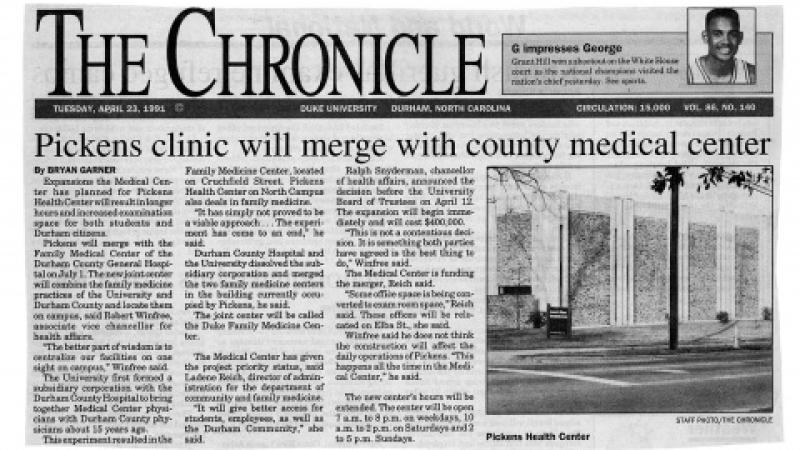
Part 6: Family Medicine at Duke - 'Family medicine is alive and well'
Editor's Note: This is the sixth in a seven-part series about the history of family medicine at Duke University Medical Center.
Read Part 1 | Read Part 2 | Read Part 3 | Read Part 4 | Read Part 5 | Read Part 7
On Oct. 7, 1985, George R. Parkerson, Jr., M.D., then-chair of the Department of Community and Family Medicine, gave an update on the status of the department in a memo to William Anlyan, M.D., then-chancellor of health affairs for Duke University. He stated that over the past six months, his objective was to analyze the programs of the department to determine which suited the needs of the medical center and which did not, the object being to make the department “a ‘fit’ rather than a ‘misfit,’” he wrote.
Parkerson wrote that he had discussed issues personally with each of the clinical chairs and that all of them had been genuinely supportive on both personal and professional levels. He recently recalled that David Sabiston, Jr., M.D., then-chair of the Department of Surgery, and Joseph Greenfield Jr., M.D., then-chair of the Department of Medicine, were supportive.
“I don’t know who was involved with trying to shut it down exactly, but when I took over they were very cooperative,” Parkerson said. “And the two main chairs at that time were surgery and medicine. And both of those chairmen were very supportive.”
Greenfield, who now works half-time at the Duke VA Medical Center reading electrocardiograms, said in a recent interview that Parkerson was very easy to work with and did a monumentally good job at making family medicine accepted.
“George Parkerson had a demeanor about him that was non-confrontational,” Greenfield said. “He didn’t try to create any kind of trouble at all, and was perfectly willing to deal with the issues that he had to deal with.”
E. Harvey Estes, Jr., M.D., original chair of the department, agreed that Parkerson was more tolerant than he was when dealing with the other clinical departments.
Duncay Yaggy, Ph.D., then-chief planning officer of Duke University Hospital, said in a recent interview that Estes made the discussion more difficult because of who he was. Estes was a cardiologist by training, having come to Duke in 1953 to practice cardiology and focus specifically on the electrocardiogram. He was recruited from the ranks of the Department of Medicine to lead the Department of Community Health Sciences in 1966.
“Harvey was not a family doc by training,” Yaggy said. “He was a world-class cardiologist. Joe Greenfield was a cardiologist. … He [Estes] was a tough player in their world.”
A second report from Parkerson, dated April 29, 1986 -- one year after becoming chair -- stated that “Family Medicine is alive and well at Duke University Medical Center.” His report outlined the success of the family medicine educational and clinical programs, including the Duke-Watts Family Medicine Residency Program.
He wrote that “significant progress has been made toward our goal of closer integration of Family Medicine into the academic medical center.”
What happened?
It will remain a mystery as to what exactly happened in the summer of 1985 to make Anlyan decide not to go through with plans to phase out the clinical operations of the Department of Community and Family Medicine, including the family medicine residency and clinic. There is no documentation at Duke University Medical Center Archives regarding what may have led to the reversal of the April decision, which was never implemented, but never technically rescinded, either.
An article published in Family Practice News on Aug. 31, 1985, cited the prospect of losing state funds as the decisive factor in Duke not following through with the decision.
According to the article, W. Donald Moore, president of the N.C. Academy of Family Physicians, said that Duke was receiving more than $1 million per year in direct grants from the state, contingent upon the presence of a family medicine program.
“Several legislators told the university in no uncertain terms that if it didn’t continue educating family physicians it would go without state funds,” Moore told the newspaper in 1985.
Parkerson, professor of community and family medicine, recently said in one sense the controversy helped to stabilize family medicine because the medical center realized the importance of keeping the referring physicians happy. Parkerson also suspected Anlyan realized what a mistake he had made when Estes resigned as chair.
“I think when … Harvey resigned, Bill Anlyan realized this is a huge mistake,” Parkerson said. “ ‘We are making a huge mistake. This is one of the best people we have at Duke and he’s been forced to resign because of what a few other chairmen want to do.’ ”
In an interview a few months before his death in August 2015, Anlyan said that in retrospect, he paid too much attention to what Sabiston was telling him, and not enough attention to Estes. He said that Sabiston was a master politician, and relied on his very dominant position as chair of the Department of Surgery.
“Well, it’s easy to sit back and say Harvey was correct, Sabiston was wrong,” Anlyan said, “But … I don’t want to condemn.”
Down the road
In 1989, the family medicine physicians on faculty in the Department of Community and Family Medicine were granted admitting privileges at Duke University Hospital at Parkerson’s urging, according to a document in the Duke University Medical Center Archives. Greenfield also said he fought hard for this to happen.
“I felt very strongly that for them to have a real presence they should have admitting privileges and have beds in Duke Hospital,” said Greenfield, James B. Duke Professor of Medicine. “And I arranged to get that done.”
On July 1, 1991, the Duke-Watts Family Medicine Residency Program and clinic moved to Duke’s campus to merge with the Pickens Health Center in the Marshall I. Pickens Building at 2100 Erwin Road, forming one unified family practice clinic in the department: the Duke Family Medicine Center. The building underwent an expansion that was fully funded by the medical center.
Parkerson said he initiated this move to further integrate the family medicine training program and clinic with the medical center. A Sept. 27, 1990, article in Duke’s student newspaper, The Chronicle, stated that financial troubles had sparked the negotiations.
In a recent interview, Amrit Singh, M.D., a 1993 graduate of the Duke Family Medicine Residency Program, recalled mixed feelings among her fellow residents about moving to Duke’s campus.
“Sometime in the spring of '91 the residents became aware we were going to be moving our residency to Pickens,” Singh recalled. “Some of the residents, especially the second- and third-years, thought that was the wrong thing to do because we were going to ... move away from a place in which we really had a role in the community. There was some discussion on the part of the residents as to whether they wanted to remain in the residency or not.”
Singh, who completed a geriatrics fellowship at Duke after residency and currently works for a hospice agency in Chicago, said that she personally was excited about the move.
“I felt that residents were always having to prove themselves to our fellow Duke residents in internal medicine and surgery that we were capable and competent,” Singh said. “I personally thought that if we were on the same playing ground we would have a chance to show the role that family medicine has in medical care and prove our worth.”
In 1994, Parkerson stepped down as chair of the Department of Community and Family Medicine and J. Lloyd Michener, M.D., was appointed chair the following year.
Duke University Medical Center’s plans for a primary care initiative specifically for employees continued and eventually evolved into what are now known as Duke’s employee health plans -- Duke Select and Duke Basic. At the time, primary care clinics were available to employees on campus at a discounted rate, said Paul R. Newman, senior vice president of Duke’s physician practice, the Private Diagnostic Clinic (PDC).
Newman also said the Duke Family Medicine Center was a qualified provider under the Duke health plan, even though the providers were not yet part of the PDC, a move that did not happen until 1995, and one that Newman pushed for.
“I basically went to Greenfield and Sabiston and convinced them that … family medicine didn’t need to be an appendage sitting out there but not part of the clinic physician enterprise,” Newman said recently.
The Division of Family Medicine was now fully integrated at Duke with its residency and clinical practice located on campus and experiencing success, and faculty granted admitting privileges at Duke University Hospital and becoming part of the PDC.
However, more turbulence was ahead.
Inpatient service at Duke University Hospital
Though the family medicine faculty and residents of the Department of Community and Family Medicine were granted admitting privileges in 1989 and given an inpatient service at Duke University Hospital beginning in 1991, it didn’t come without its challenges.
Kathryn M. Andolsek, M.D., MPH, then-director of the Duke Family Medicine Residency Program, said when the faculty and residents moved their service from Durham County General Hospital to Duke University Hospital, their patient beds were located in Duke South, not Duke North where the majority of the hospital’s inpatient care was handled.
She recalled the family medicine beds being located on a beautiful hallway with plenty of windows in Duke South, but said the distance from Duke North was difficult and she was concerned for her residents’ safety and well-being, going back and forth between North and South in the middle of the night.
“Most of our patients were there [at Duke South], but our babies and children were over at Duke North. Our monitored beds for step-down unit patients … were over in Duke North,” Andolsek recalled. “So residents had to run back and forth. And at that point in time it felt like it was a longer distance between these two facilities, because there was less build-up in between. Geographically it just meant that there was a lot of walking around.”
She also said that if one of their Duke South patients coded and had to be moved to a monitored bed in the intensive care unit, either a code team had to come to Duke South or the patient had to be taken in an ambulance to the emergency department at Duke North to be readmitted.
“The residents hated it. They felt completely marginalized for the care of their patients here [in Duke South],” Andolsek said. “We still had patients we were caring for in North, too, but it just was not a good message for them [the residents] that the patients that coded had to be readmitted.”
Singh was a second-year resident when the inpatient unit opened at Duke South and in a recent interview recalled some of the same frustrations.
“I personally remember being part of the care for a patient who coded who needed immediate assistance. And we got the assistance, but then it became apparent that there was a limitation to having patients on Duke South,” Singh recalled. “And it became frustrating that we weren’t able to admit to beds in Duke North at that point.”
Singh recalled that she was really happy to be at Duke South, though, and that it was the beginning of a stronger stance for family medicine in the Duke community.
“There was a lot of uncertainty initially, but it was a very exciting time, I think, for family medicine and it was a good chance for us to prove ourselves and to show what we could do,” Singh said.
